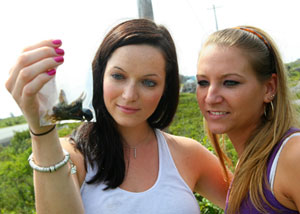 |
| Dal student Carolyn Inglis and Patricia Smith take a look at their sample bags. (Nick Pearce Photo) |
This is not the usual jaunt to PeggyвҖҷs Cove, where you go to jump from rock to rock, take pictures of the lighthouse and complain about having to pay for parking at the SouвҖҷWester.
No, this trip is definitely different. В鶹ҙ«ГҪ students walking the shore of PeggyвҖҷs Cove are on the lookout for the tiny creatures and plants that live on or near those famous rocks: the kelp, the barnacles, Irish moss, periwinkles and algae.
вҖңPeggyвҖҷs Cove is a standard example of a rocky shore in the Atlantic region,вҖқ explains ecologist Christopher Corkett, the Dal professor who teaches Introduction to Marine Life of Nova Scotia (), one of the classes of the В鶹ҙ«ГҪвҖҷs Seaside program.
вҖңAt PeggyвҖҷs Cove, we can see вҖҳzonation,вҖҷ a general principal in ecology where we see the patterns of algae in zones.вҖқ During the class, students also visit other seashore environments, including a sandy beach and a salt marsh.
SEE PHOTOS: AВ different perspective on Peggy's CoveВ by Nick Pearce
SeasideвҖ”Summer Education and Applied Science Institute at В鶹ҙ«ГҪ in EcologyвҖ”provides a unique experience, getting students out of the classroom and into the great outdoors. Offered through the Faculty of Science, the Seaside program is all about the field trips. For Orinthology (), for example, the scientific study of bird populations, students visit sites near Halifax on day trips and spend six days camping in southwestern Nova Scotia, at the Harrison Lewis Field Station in Port Joli. For Field Studies of Marine Mammals (), students camp for two to four days on Brier Island at the peak of whale-watching season.
On this misty morning, the students taking Marine Life depart the bus parked just at the entrance to PeggyвҖҷs Cove and follow their professor over boulders and through bogs to the seashore. Once at the edge of the sea -- with the iconic lighthouse barely visible across the bay in the fog -- Dr. Corkett instructs them to collect samples from tidal pools. TheyвҖҷll take a look at their samples under the microscope back in the laboratory.
вҖңSomething green and blobby works for me!вҖқ says Kyle Mustard, a second-year student majoring in history and sustainability,В as he peersВ into a rust-colored crevice. The class, which counts as a half-credit, is geared to non-science majors and attracts students in a wide variety of disciplines.
вҖңFor me, itвҖҷs a good way to see Nova Scotia and to learn about it from a scientific perspective,вҖқ says Alberta native Carolyn Inglis, a student in environmental science and international development studies. She explains she was attracted to В鶹ҙ«ГҪ for its reputation as a top science school and it hasnвҖҷt disappointed. вҖңI love it, absolutely, itвҖҷs the best,вҖқ she enthuses.
LINK:
